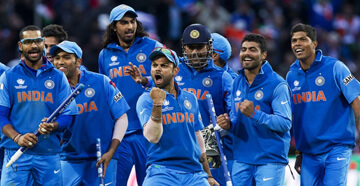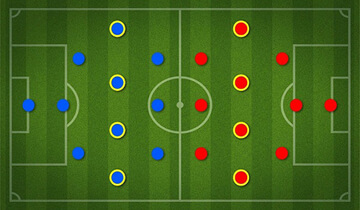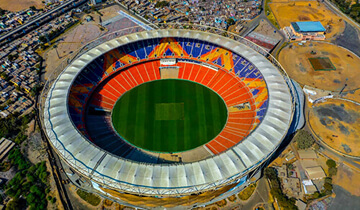Cricket Pitch: Dimensions, Markings, and Key Elements
Cricket is played on a large grass field with a rectangular pitch in the center. The pitch is crucial to the game of cricket as this is the area where the bowler bowls to the batsman. The standard length of a cricket pitch is 22 yards (20.12 meters). The standard width is 10 feet (3.05 meters). There are several key elements marked on the pitch that are important for gameplay. In this article, we will look at the dimensions of the cricket pitch, the key markings, and the role each element plays.
Length and Width
As mentioned above, the standard length of the pitch is 22 yards or 20.12 meters. This length has remained unchanged since the early days of the sport. The width of 10 feet or 3.05 meters is also standard. Minor variations in length and width are allowed but any major deviation could provide unfair advantage. The consistent dimensions allow for balanced competition across different venues.
Crease Markings
There are several lines marked on the pitch called creases. The most important ones are the popping crease, bowling crease, return creases, and wicket lines. The popping crease is marked in front of both wickets. It is the line where the batsman stands to receive the ball from the bowler. The bowling crease marks the end of the pitch where the bowler releases the ball. The return creases mark the width of the pitch perpendicular to the wickets. All of these crease lines help define the playing space for the bowlers and batsmen.
The Wickets
At both ends of the pitch stand a set of three stumps, known together as the wicket. They are placed along the bowling crease with equal distances between them. Two bails balance on top of the three stumps. If the bowler hits the wicket and dislodges the bails, the batsman is dismissed. The wicket dimensions are critical for fair gameplay.
The cricket pitch has some precisely defined dimensions and markings that affect gameplay in important ways. Understanding the standard length, width, creases, and wickets provides insight into the sport. Consistent dimensions allow for balanced matches across different cricket grounds. The pitch layout creates a fair contest between bat and ball.
Dimensions & Measurements of a Cricket Pitch
Cricket is played on a rectangular grass field with a pitch in the center. The pitch is the key part of the field where most of the action takes place. The dimensions and measurements of the cricket pitch are standardized, but may be slightly modified for junior cricket.
Length and Width of the Pitch
The length of the pitch is 22 yards or 20.12 meters between the two sets of wickets. The total length of the pitch including the run-up area at both ends is about 24.6 yards.
The width of the pitch is 10 feet or 3.05 meters. This is the distance between the return creases on either side of the pitch. The total width including an extra strip of grass on each side is 12 feet or 3.66 meters.
Bowling Crease
The bowling crease is marked at each end of the pitch in line with the stumps. It is 8 feet 8 inches long or 2.64 meters. The bowling crease marks the area where the bowler must land their front foot during delivery. If the bowler oversteps this line, it is called a no-ball.
Popping Crease
The popping crease is marked 4 feet or 1.22 meters in front of each set of stumps. This is the line where the batsman must be within when playing a shot. It marks the edge of the safe territory for batsmen. If they cross the popping crease, they risk being stumped or run out.
Return Creases
The return creases are the lines perpendicular to the popping crease near the edges of the pitch. They mark the maximum width of the pitch. The return creases are 8 feet 8 inches or 2.64 meters apart from each other. This defines the wide line for judging wide deliveries.
Stumps and Bails
The wickets which the batsmen defend are made up of three vertical stumps with two horizontal bails resting on top.
The stumps are 28 inches or 71.1 cm tall and no more than 1.38 inches or 3.5 cm wide. They are hammered into the ground in line with the bowling creases. The stumps are placed 22 yards apart at either end of the pitch.
The bails sit loosely on top of the stumps. The bails are 4.31 inches or 10.95 cm long. They help dislodge if the wicket is hit. The bails should weigh between 1.6-1.94 ounces or 45-55 grams.
Junior Cricket Pitch Dimensions
For junior cricket, especially for younger age groups, the pitch dimensions may be slightly modified. This is done to accommodate their lower skill levels.
The pitch length is often reduced to 16 or 18 yards instead of the full 22 yards. The popping and bowling creases are moved closer while maintaining the 4 feet distance between them.
The width of the pitch may be reduced to 8 feet instead of 10 feet. The return creases are brought in accordingly. Smaller stumps and lighter bails are sometimes used as well.
These minor modifications help junior players develop their skills. As age and skill level increases, they graduate to the full standard pitch dimensions. The basic shape and layout remains the same. Only the distances are shrunk to suit the younger players.
The standardized dimensions and measurements of the pitch, creases, stumps and bails are important to maintain consistency and fairness in cricket. They govern key aspects of play and strategy for both batsmen and bowlers. Even small variations in these dimensions can impact the nature of the contest. Governing bodies carefully specify the dimensions to preserve the balance between bat and ball.
Pitch Layout & Markings
Creases
Cricket pitches have several crease markings that serve important purposes in the game. The main creases are the bowling crease, popping crease, and return creases.
The bowling crease is marked at each end of the pitch and is the line that a bowler must have some part of their front foot behind when they deliver the ball. This line ensures that the bowler does not unfairly advance down the pitch when bowling. The bowling crease is 8 feet 8 inches long, centered on the middle stump at each end.
The popping crease is marked 4 feet in front of each set of stumps and runs parallel to the bowling crease. This is the line batsmen must be within when playing a shot or risk being stumped. It ensures they do not back up too far down the pitch.
Return creases are marked perpendicular to the popping crease and extend 4 feet behind the stumps on both sides. These act as guides for the umpires when determining if bowlers are illegally encroaching into the protected area behind the stumps when following through after delivering the ball.
Location of Wickets
The wickets are located in the center of the bowling creases at each end of the pitch. The stumps are equal distance between the return creases on either side.
The stumps are vertical wooden structures made up of three wooden stakes hammered into the ground: two outer stumps and a middle stump placed between them. The stumps are 28 inches tall with equal sized bails placed horizontally across the top.
The arrangement of the stumps and precise measurements are critical for determining legal delivery of the ball, appeals for wickets, and scoring methods.
Pitch Preparation
Cricket pitches are prepared in the center of a large rectangular grass field area called the square. This entire square area allows for multiple pitches to be prepared for different matches.
The actual cricket pitch is a carefully prepared strip of earth 20 meters long by 3 meters wide. It runs between the two sets of stumps described earlier.
The pitch is prepared by rolling and leveling the surface, then mowing the grass very short. The short grass allows the ball to bounce more uniformly than on the rest of the field.
This provides batsmen with a consistent surface to face bowlers and allows for fair competition between bat and ball. The even bounce rewards bowlers who can make the ball move in the air or off the pitch surface.
Boundary Markings
The outer perimeter of the cricket field is marked to define the playing boundary. This boundary is typically a rope or line marked all the way around the edge of the field.
For international matches, the recommended minimum boundary size is 59.43 meters (194 ft 10 in) from the center of the pitch to the edge of the field, however dimensions can vary.
Boundaries are a major part of gameplay strategy. Batsmen often aim to hit balls past the rope for automatic 4 or 6 runs. Meanwhile, fielding teams position players to prevent boundary shots.
Infield, Outfield and Close-Infield Markings
Additional field markings help define player positions and strategies. The infield is the area closest to the bat and includes positions like point, silly point, short leg and others.
Farther out is the outfield, including positions like long off, deep cover, deep midwicket and more. Positions in the outfield have opportunities to take catches on longer boundary shots.
Between the infield and outfield is an area called the close-infield. This region allows for attacking and defending field placements like short extra cover, silly mid-off, short midwicket and similar positions.
By preparing the pitch with defined creases, establishing the stumps, mowing the grass to a specific height, and marking the boundaries and fielding regions, a cricket field is carefully laid out to enable balanced gameplay between bat and ball. The markings allow umpires to adjudicate play fairly and provide a visual reference for players and spectators alike. All of these pitch and field markings have evolved over time to produce the standardized cricket setup recognized today.
Differences between natural turf and synthetic pitches
Natural turf pitches
Natural turf cricket pitches are made of soil, usually a combination of clay, silt, and sand. The preparation of a high-quality turf pitch is a precise science requiring extensive groundskeeping. The grass type, soil composition, drainage, and rolling/watering schedule all affect the way the ball will react when bowled along the pitch.
In professional cricket, turf pitches are usually left with some grass cover to allow for consistent bounce and movement. Too much grass can cause variable bounce, while a bare pitch tends to break up and become dusty. The evenness of the surface is critical - any cracks or bare patches can alter the path of the ball. Turf pitches typically offer more variation as the game goes on and the surface wears, often becoming more spinner-friendly late in a match.
Synthetic pitches
Synthetic pitches are made using man-made materials to create a consistent artificial surface. The synthetic fibres are woven and filled with sand and rubber granules to mimic the properties of natural turf. Synthetic pitches are more durable and weather-resistant than natural turf pitches.
The main advantage of synthetic pitches is their uniformity. The bounce and pace stay consistent throughout the match. Spin bowlers tend to get less assistance compared to turf pitches. Synthetic surfaces offer a truer bounce that may favor batsmen. The downside is that the ball doesn’t deteriorate over the course of a match in the same way, so there is less variation for bowlers to exploit.
Modifications to length of pitch for junior levels
The standard length of a cricket pitch is 22 yards (20.12 m). However, for junior and amateur levels, it is common to use a shorter length pitch. The main reasons for this are:
- Junior players lack the strength to bowl accurately over the longer distance
- Younger batsmen struggle to hit longer boundaries
- Shorter pitches encourage more interactive, dynamic cricket
The specific shortened distance varies by age group and playing conditions. Some common junior cricket pitch lengths include:
- Under 11: 16 - 18 yards
- Under 13: 18 - 20 yards
- Under 15: 20 - 22 yards
Gradually increasing the pitch length helps junior players develop their batting and bowling skills. Maximum pitch lengths are often defined in junior cricket regulations. Even senior amateur cricketers will sometimes use a shortened pitch for convenience or to speed up the pace of the game.
Indoor cricket pitch dimensions
Indoor cricket is played in sports hall and stadium environments. The pitch and fielding dimensions are modified to suit the indoor playing conditions.
Some key regulations for indoor cricket include:
- Pitch length is 18.29m (20 yards)
- Boundary is usually 45m-55m from the batsman’s end
- Higher walls than outdoor grounds around the perimeter
The shorter pitch suits the indoor game by making scoring easier for batsmen. Bowlers can use the walls as a tactic by aiming for catches close to the boundary.
Other changes from outdoor cricket include using a smaller, lighter ball and restrictions on dangerous bowling actions that could damage the gymnasium flooring. Tactics and shot selection may differ, but indoor cricket uses the same basic rules as the outdoor game. Converting indoor venues into temporary cricket grounds has helped increase the global reach of the game.
Conclusion
Cricket is a sport defined by the precise dimensions and markings of its central playing arena - the pitch. The standard length of 22 yards and width of 10 feet have remained consistent for decades to enable fair contests between bat and ball. Key pitch markings like the popping crease, bowling crease and return creases form boundaries that govern gameplay. The carefully measured stumps and bails further reinforce the importance of standardized dimensions.
While the traditional grass pitch offers subtle variations as the match progresses, synthetic surfaces provide unerring uniformity that changes little during play. Shortened pitch lengths are commonly used in junior cricket to help develop skills before graduating to full length. Indoor cricket adapts the layout and boundaries to suit confined spaces. Regardless of playing conditions, the enduring spirit of cricket shines through.
In the end, the dimensions matter because cricket at its heart relies on a balanced contest between bowler and batsman. As the future of cricket evolves with technology and innovation, the pitch must continue enabling this graceful duel. Carefully constructed grounds will preserve traditions while allowing cricket to flourish as a global sport open to all. Consistent dimensions not only connect today’s game to its origins, but also serve the athletes who dedicate their lives to mastering the sport on pitches that span the world.







































